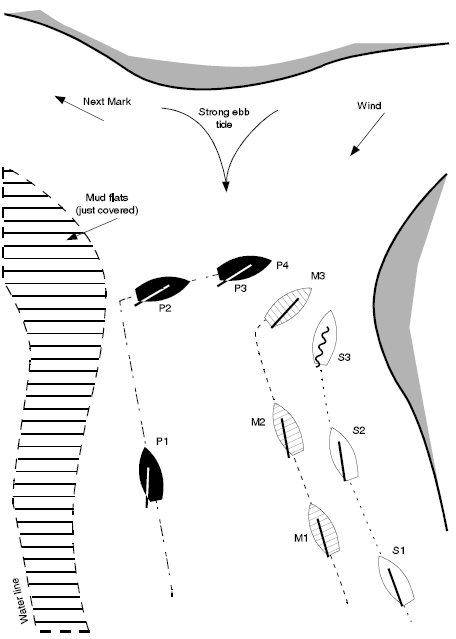(This is an instalment in a series of blogposts about the ISAF Case book 2009-2012 with amendments for 2010. All cases are official interpretations by the ISAF committees on how the Racing Rules of Sailing should be used or interpreted. The cases are copied from the Casebook, only the comments are written by me.)

CASE 10
Rule 20.1, Room to Tack at an Obstruction: Hailing and Responding
Rule 64.1(b), Decisions: Penalties and Exoneration
Rule 64.1(c), Decisions: Penalties and Exoneration
Definitions, Obstruction
When two boats are involved in an incident and one of them breaks a rule, she shall be exonerated when a third boat that also broke a rule caused the incident.
Summary of the Facts
As P approached the mud flats, she tacked onto port. M, on starboard tack, immediately hailed and then hailed again when one hull length away, since it was apparent that P was trying to cross ahead and a collision would be inevitable. When there was no response to her hails, M tacked, hailing S as she was going about. S tried to respond but there was contact. P retired promptly after the incident because her crew believed she had gained an advantage over M and S who had lost considerable time as a result of the contact between them. S protested M under rule 10. The protest committee, commenting that M had sufficient time to take avoiding action to keep clear of both P and S, disqualified M under rule 14.
M appealed, asserting that the protest committee erred in suggesting that she, a right-of-way boat, was obliged to keep clear of P. Furthermore, after her second hail, had she borne away and then P finally responded by tacking, contact would have been likely. M also alleged that S had not given M room to tack as required by rule 20.1.

Decision
P broke rule 10. When she retired promptly after the incident, she took the applicable penalty and is not to be penalized (see rule 64.1(b)).
S was subject to rule 14, but did not break it as it was not possible for her to avoid contact. Rule 20.1 did not apply between M and S because, according to the definition Obstruction, P was not an obstruction since M and S were not required to keep clear of P.
M, in the circumstances, took proper action to mitigate the effects of P’s error of judgment. Both M and S were the innocent victims of P’s breach of rule 10. M broke rule 13, but is exonerated under rule 64.1(c). M’s appeal is upheld. M is to be reinstated.
RYA 1964/8

I have a question for you, regarding this third boat.
We all know that a procedure has to be stopped and restarted when the PC has found that a third boat might be involved and might have broken a rule. That usually means that the whole hearing is pushed to the next day, in order to locate and protest that third boat.
Have any of you ever been in a protest where the third boat was not or could not be identified. Both parties agree on the facts found, they agree that the third boat was the ‘root’ cause of the incident, but can’t remember which boat it was.
Did you still exonerate the ‘middle’ boat? Without finding the guilty boat and penalizing her?
J.























